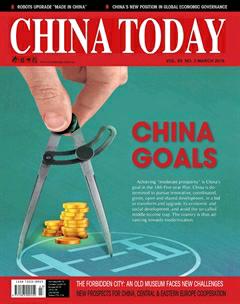Goals in Five Years
Chinas GDP reached RMB 67.67 trillion in 2015, up 6.9 percent year-on-year. The GDP figure was in line with international standards and accepted by international organizations, including the United Nations Statistical Division, the International Monetary Fund, and the World Bank. China, which accounts for 15 percent of the world GDP and contributes to 25 percent of global growth, remains a source of strength for the global economy.
From this year till 2020, China expects to sustain its GDP growth at around 6.5 percent as part of an economic restructuring that involves slowing down its growth rate. The country hopes that domestic consumption and innovation can offset the negative effects of weak exports and investment performances. At the same time, greater emphasis will be put on enhancing the quality of economic development and seeking a late-mover advantage. More action will also be taken to protect the environment, improve peoples livelihood and continue contributing to the worlds economic progress.
Despite a downgraded forecast, the Boston Consulting Group and AliResearch projected in a joint survey that Chinas consumer market will increase by nine percent annually and reach US $6.5 trillion by 2020. The study says that the combined number of upper-middle class Chinese families with annual disposable income between US $24,000 and US $46,000, as well as affluent families with annual disposable income above US $46,000, will surpass 100 million by 2020, making up 30 percent of the countrys urban households. The figure currently stands at 17 percent, up from seven percent five years ago. In five years, this segment of the population will contribute to 55 percent of urban consumption and 81 percent of consumption growth.
Demand, a driving force for the economy, guarantees Chinas medium-high growth and facilitates higher-quality growth. To meet considerable market demand – especially from the medium- and high-income groups – supply-side reform has been undertaken to prevent vicious competition and environmental pressure generated by supply exceeding demand. Products of higher quality and in greater varieties will be provided.
Through the Internet, huge numbers of people are getting involved in entrepreneurship. They have developed products and services that not only make our lives easier but also stimulate the advancement of a strong economy.
Technological innovation will also add new impetus to Chinas future economy by upgrading traditional industries, eliminating outdated capacity, beefing up new industries and service sectors, as well as optimizing industrial structures.
Economic progress will bring better living conditions. By 2020, the ratio of Chinas permanent urban residents to its total population should reach 60 percent. More city clusters will take shape, created by the growth of key cities.
Meanwhile, the number of small and middle-sized cities will increase. Services in small towns will be upgraded. Urban residents will all have access to public services, including free and compulsory education, career services, basic pension, basic medical treatment, and affordable housing.
In five years time, 100 million rural migrant workers in cities will become registered urban residents to ensure their equal entitlement to urban social security services. On top of that, the government vows to improve housing conditions for 100 million people, guide the urbanization of 100 million rural residents in the central and western Chinese regions, as well as lift around 70 million people beyond the poverty line.
Environment-friendly measures are expected to be carried out more widely in the fields of industry and daily life. The use of energy-conserving and water-saving facilities, recycled products and green architectures will continue to rise. The ecological environment will improve, including air quality and drinking water safety. Natural landscapes and cultural relics will also be better preserved.
In 2015, 10 of Chinas provincial-level regions registered a per-capita GDP of over US $10,000 – one more province than the previous year. In the same year, the expenditure of Chinese tourists overseas reached RMB 1.2 trillion (about US $183 billion), an increase of RMB 20 million year-on-year. The push for continued economic development is expected not only to help China shake off poverty, but also enable different Chinese regions to overcome the “middle-income trap.”

